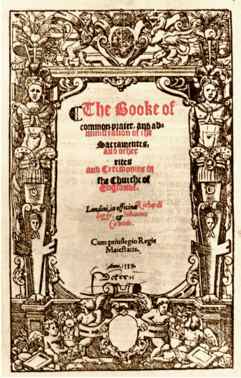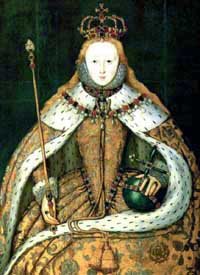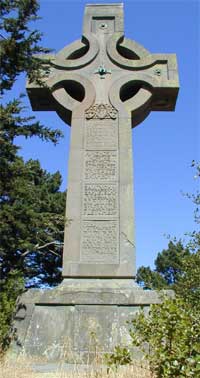|
The
Elizabethan Prayer Book
The Prayer Book of 1559 was the third revision for the Anglican Church,
and was brought about by the accession to the throne of Elizabeth I and
the restoration of the Anglican Church after the six-year rule of the
Catholic Queen Mary. It was in use much longer than either of its predecessors
- nearly 100 years, until the Long Parliament of 1645 outlawed it as part
of the Puritan Revolution. It served not only the England of Elizabeth
I, but her Stuart successors as well. This was the first Prayer Book used
in America, brought here by the Jamestown settlers and others in the early
1600's.
|

 |
| Queen
Elizabeth's coronation portrait, in 1559. |
 |
| Cross
in Golden Gate Park, San Francisco, commemorating the first
BCP service in the U. S., by Sir Francis Drake's chaplain, 1579. |
|
This Book was a conservative
revision of the 1552 edition, with the effect of making it somewhat less
"Protestant". It put to a halt the movement in the previous two
Prayer Books towards a more Protestant church. Some of the few changes made
included:
- Dropping the very
last rubric in the Communion service (called the "Black Rubric"),
which had sought to assure that kneeling during Communion did not in
any way imply worship of the elements;
- Combining the
two versions of the sentences used for administration of the elements
during Communion from the previous two Prayer Books;
- Dropping prayers
against the Pope from the Litany; and
- Adding a rubric
to Morning Prayer prescribing the use of traditional vestments.
A
number of Saints' days and festivals were added to the Kalendar in 1561;
these are also noted. Some minor changes were also made in 1604 on the
accession of James I. The most important of these was to lengthen the
Catechism by adding sections on the Sacraments.
These
changes may be seen by comparing this text with that of the 1552 Book.
The
translation used for the Biblical texts of this prayer book was that of
the Great Bible of 1539; this was also the source for the Psalter for
this and for all Prayer Books down through the US 1928 BCP.
The
Communion Service is also available online in
modern spelling.
Other versions of the 1559 BCP available online include these printings:
- 1562 (Griffiths 1562/1), from the Benton Collection at the Boston Public Library.
- 1564, Jugge & Cawood (Griffiths 1564/2)
- 1581 (Griffiths 1581/1), from the BPL
- 1582 (Griffith 1582/2); has several leaves missing in the front.
- 1584 (Griffiths 1584/1?), from the Univ. of Pennsylvania.
- ~1588.
- 1589 Bible version (Griffiths 1589/1)
- 1599 (Griffiths 1599/1) from the BPL.
- 1605 (Griffiths 1605/2) from the BPL.
- 1611 Griffiths 1611/1); several leaves missing in the front.
- 1613, Griffith 1613/5 (some leaves missing)
- 1614, Barker Bible version (Griffiths 1614/1)
- 1615 Bible version, Griffiths 1615/3
- We have a 1623 “Bible version” (Griffiths 1623/1).
- 1628 Bible version, Griffiths 1628/3
- 1630, Barker & Bill Bible version (Griffiths 1630/7)
- 1631, Barker & Bill (Griffiths 1631/1)
- 1631, Barker & Bill (Griffiths 1631/2)
- 1633 unsanctioned printing, Griffiths 1633/10
- 1634 (Griffiths 1634/3 - although the date in the book is 1636).
- 1634, Barker & Bill (Griffiths 1634/2)
- 1635 Cambridge Bible version, Griffiths 1635/1
- 1635, Barker & Bill Bible version (Griffith 1635/2)
- 1637 with KJV Bible, Griffiths 1637/5.
- 1638, Cambridge Bible version (Griffiths 1638/4)
- 1641 Bible version, Griffiths 1641/4
- 1660 Bill & Barker, London
(Griffiths 1660/7)
- 1660 Barker, London (Griffiths 1660/2)
Also, these reprints:
- A reprint of the 1559 BCP is also available online
as part of Liturgies and occasional forms of prayer set forth in the
reign of Queen Elizabeth, William Keatinge Clay, ed. (1847; Griffiths
1847/11) from
the Internet Archive
- Google Books has two of the Pickering (typeset) facsimiles from 1844: one of the first
(1559) printing (Griffiths 1844/28), and the other of the 1604
edition (Griffiths 1844/29) reflecting the changes made then. The 1604 edition is also available from the Internet Archive.
- We also have online a Latin translation of the
1559 BCP, first published in 1560 the first Welsh translation, from 1567, and a 1638 Greek translation (along with a Greek New Testament).

- The Internet Archive has a 1902 history of this book, The Elizabethan Prayer-book & Ornaments, by Henry Gee. "Ornaments" refers to what the priest was required or permitted to wear during services, and was controversial at that time.
All of these but the first are available as PDF graphics; the copy from the Univ. of Penn. is presented as a series of photographs. "Griffiths" indicates references appearing in David Griffiths' Bibliography of
the Book of Common Prayer. A "Bible version" is a printing intended to be bound with a Bible. These typically were in a smaller, Roman (rather than Blackletter) font, and often omitted certain rubrics and services.
A number of temporary "supplements" to this book were periodically issued in response to current problems, such a plague, war, etc. Some of these are online:
A fourme to be used in common prayer twyse aweke, and also an order of publique fast, to be used every Wednesday in the weeke, durying this tyme of mortalitie, and other afflictions, wherwith the realme at this present is visited. (1563) 
A forme of common prayer, together with an order of fasting: for the auerting of God's heauy visitation vpon many places of this kingdome and for the drawing downe of his blessing vpon vs, and our armies by sea and land.
(1625) 
A forme of prayer, necessary to bee vsed in these dangerous times, of warre and pestilence, for the safety and preseruation of his Maiesty and his realmes (1626) 
A forme of common prayer; to be used upon the eighth of July: on which day a fast is appointed by His Majesties proclamation, for the averting of the plague, and other judgements of God from this kingdom. (1640) 
Notes
on the text:
The text is presented in two formats: HTML and PDF (or Adobe
Acrobat). The HTML text used here is from a reprint, The Prayer Book
of Queen Elizabeth 1559, published in 1890 by Griffith Farran Okeden
& Welsh (Griffiths 1890/7). That text, in turn, appears
to be taken from an edition published by Richard Grafton of London in
1559. It uses completely the original language and spelling, which are
largely retained here. Changes introduced in 1604 are taken from an original
edition published in 1634. The Book of Common Prayer, 1559, edited
by John Booty and published by the Folger Shakespeare Library in 1976,
and Liturgiae Britannicae, by William Keeling (publ. 1851), were
also consulted. Additionally, The State Prayers and other Variations
in the Book of Common Prayer, by Frank Streatfeild (1950), was used
for the variations in the State Prayers found in the Litany.
The
HTML text of the reprint has been modernized as follows:
- When a vowel would,
in modern usage, be followed by an "m" or "n", this
was sometimes indicated by the vowel-macron, or the vowel with a horizontal
line over it, and the "m" or "n" was omitted. As
the vowel-macron is not part of the standard ASCII character set, these
characters have been replaced by their modern equivalents; i. e., the
"m" or "n" has been added.
- The letters "j"
and "v" were hardly, if ever used in the original text, being
represented by "i" and "u", respectively. The text
here replaces "i" and "u" with "j" and
"v", as appropriate.
- The "u"
in words starting with that letter (e. g., "us") was represented
by a "v"; we have replaced the "v" with "u"
in such cases.
- The lower case
"s" was often represented by something which looks much like
a modern-day "f"; the modern "s" is used everywhere
here.
- If a word is obscure
or has a different meaning today, the modern equivalent is noted in
brackets in the text.
- The reader will
quickly notice that spelling was not standardized then as it is today.
Many words have a number of different spellings within the text. This
can be easily seen, for example, in the Benedicite omnia opera
in Morning Prayer, where "Lord" sometimes has a final "e",
and sometimes not, and usually is capitalized, but sometimes not; and
"praise" is is sometimes spelled with a "y" and
at other times with an "i". It is important to note that spelling
was also not uniform among the different printings of this book.
The fonts and general
appearance of the text did not (as far as I can determine) change greatly
over the different printings of this book. In later printings, however,
spelling became more and more standardized and more like that used today.
By 1600, for example, the vowel macron appears to have disappeared, while
the the transposition of u's and v's lasted at least until the 1630's.
Its appearance in 1634 can be seen in the PDF version, which does not
use any of the modernizations mentioned above.
For
the HTML text, we do have several images of pages of the 1559 original
placed at appropriate places so you may see just what the original looked
like. Typically, the text was in blackletter ("Old English")
in the original, and the rubrics in italics or in Roman type. As blackletter
is not a common font, nor is it particularly readable, the text here is
in Roman and the rubrics in italic.
It is
to be expected that this edition, which is more than 400 years old, uses
some archaic English words. What might not be expected is that certain
words used here have entirely different meanings nowadays than they did
in the 1500's. Some of these, with their definitions with respect to this
text, are:
- Let:
hinder, prevent (i. e., opposite to what it means today)
- Prevent:
to go before.
- Person:
Sometimes means "parson"
- Like:
please
- Travail:
Sometimes means "travel"
- Affiance:
faith
About the
PDF files
The PDF text is taken
from an original edition published by Robert Barker in 1634; it is intended
to appear as much like the original as possible. This particular edition
is listed in David Griffith's Bibliography of the Book of Common Prayer
as 1634/1, and appears to be similar to editions published by Barker throughout
the 1630's. The basic PDF text comes from the older HTML text, adjusted to agree with the 1634 copy in spelling, punctuation,
etc.
The woodcuts and
other decorations all come from this particular book, although they
weren't necessarily used in the places you see them in the PDF text.
This is because, due to the book's binding, it was not possible to
scan in woodcuts and other decorations on the pages on the right-hand
side.
The fonts used were
JSL Blackletter
and Founder's Caslon, from HW Caslon
& Co. (now sold by ITC). These were chosen for their similarity to
the original text, and the fact that they contained all the required
ligatures and other special characters.
All the PDF files are also available as a single file (size = 9.7MB)
Additionally, we have a scanned PDF version of the 1634 Book used above (127MB); note that this is an imperfect copy with a few pages torn and a few others missing. The book includes everything in the Table of Contents below, plus a 1634 Psalter (53MB) and a 1634 Sternhold & Hopkins' Psalms in Metre (76MB).
|